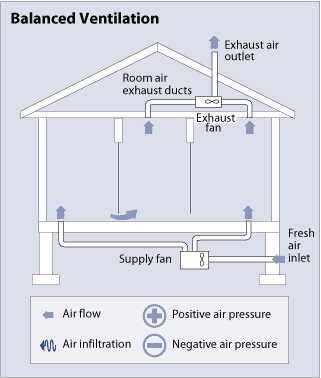The fan draws in fresh air from the lower vents pushing the warmest air highest in the roof out through the high vents.
Exhaust fan into roof cavity.
It could also lead to problems with moisture in the roof cavity.
Anon if i understand your original question you have a bath exhaust that is discharging into a roof cavity or space not to outside.
It s important to make a thorough assessment of the existing spaces where air may enter and exit the roof cavity.
When connecting a bathroom fans to ducting consideration needs to be given as the length of duct will sometimes impact air capacity especially on bathroom exhaust fans with smaller capacities.
The location of bathroom exhaust fans can also determine how effectively the fan operates.
A ceiling exhaust fan is one of the most popular methods of ventilating a room.
Of course it s unusual for a roof to have no existing ventilation.
The master flow erv5 power roof vent is the master flow erv5 power roof vent is a great overall investment in attic ventilation.
It needs to exhaust to the exterior.
Am i missunderstanding that you are thinking of blowing the exhaust air into a 100mm cavity between the ceiling and the roof.
Those ceiling vents are fine to vent off into the roof space i think the recommendations for a bathroom is 50litres per sec which u will roughly get from a ceiling fan.
Methinks this will not provide the important air exhaust that is required to keep a bathroom moisture level under control.
It can quickly remove a larger volume of hot and or humid air from your attic when compared to static ventilation.
I would say that the bathroom exhaust fans are original or close to original to the house which is mid 1970 s.
Inline fans are like anything else spend good money on them and you will get a quality fan eg less noise and vibration.
Bathroom exhausts are commonly ducted to the outside however many people decide to simply exhaust into a roof space or cavity.
This in turn can help save money on your heating and cooling costs.
The metal visible below the exhaust duct was put in place to reinforce the supporting web between the i trusses.
On 2020 02 26 by anonymous.
Hot air exhaust vents located at the peak of the roof allow hot air to escape.
I m no master builder but i do not see any signs of mold or rotting in the ceiling at all and when we purchased the property 3 years ago the building inspector explicitly stated that.
In no case is it acceptable to just dump any exhaust fan directly into an attic.
The rangehood is perhaps only 5 7 years old.
Intake vents located at the lowest part of the roof under the eaves allow cool air to enter the attic.
A ceiling exhaust fan as the name suggests is an exhaust fan that is mounted on a ceiling.
The bath exhaust vent duct is routed through the ceiling between i trusses used to support the roof over the wall top to the building exterior into the soffit cavity.

